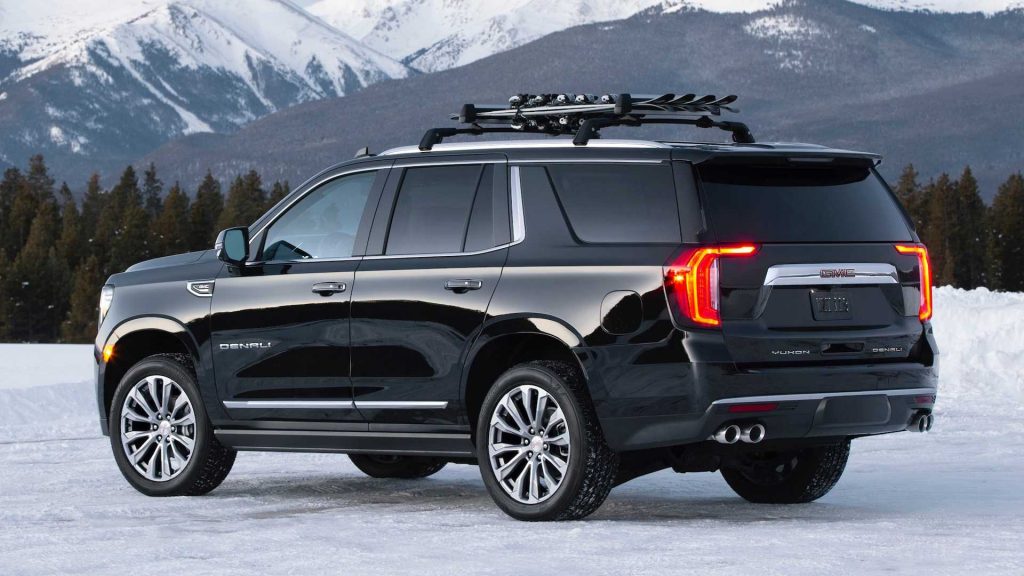I’m sure you’re as tired of reading about supply chain issues causing inventory shortages as I am about writing about it, but if you’re in the automobile industry, there is NOTHING else more important to talk about. I had hoped the new year would show signs of improvement, but unfortunately the opposite is happening. COVID shutdowns are declining (at least directly), but other hurdles have risen that more than offset any improvements.
![]()
Microchip supplies are the major limitation now. The manufactures and auto suppliers order chips several quarters in advance, in huge batches. When COVID hit, everyone cancelled chip orders. Chip manufacturers shifted to computers, webcams, gaming consoles, and telecommunications equipment where demand spiked with the pandemic. When auto demand rebounded quicker than anyone expected, recovering chip supplies for cars is like turning an ocean liner.
Then, SNOWPOCALYPSE shut down petrochemical processing plants, who’s output is used for plastics, resins, and foams in vehicles. Additionally, the Feb. 13th earthquake in Japan took down several auto suppliers. Then last week there was the Suez Canal blockage and Japan suffered a plant fire that will make the microchip supply even scarcer.
Supply chain issues have impacted every major manufacturer, but certain models have been just decimated. Of our most popular models, these have been hit the hardest:
GMC Yukon & Yukon XL
Chevy Suburban & Tahoe (Tahoe inventory is down over 75%)
Cadillac Escalade
Jeep Wrangler
Toyota 4Runner
All Chevy Trucks
All Heavy Duty Trucks
Land Rover Range Rover
Mercedes All Models
BMW X5 & X7
This has certainly led to a seller’s market. Rebates are down and prices are up. Does that mean it’s a bad time to buy a new car? Not necessarily. Late model used vehicles have increased in value faster than new car prices. Trade-ins have NEVER been worth more, particularly if you have 60k miles or less. Just be patient while we find you a new vehicle.
Where Dealerships REALLY Make their Money
You’ve heard me say repeatedly that the price of the car is not that important. Many dealers will advertise prices that are well below actual cost to lure you in. They make up that loss (and then some) with dealer add-ons, low-ball trade-in bids, and back end finance products.

Dealers make money on the front end and the back end of a vehicle transaction;
Front End
- Vehicle Price
- Trade-in Value
- Dealer Add-ons/Addendum
Back End
- Finance Reserve (interest rate markup)
- GAP Insurance
- Credit Life & Disability
- Extended Warranty
- Tire & Wheel Protection
- Windshield Protection
- And More!
AutoNation, the largest dealership group in the country, makes an average back end profit of $2,172 per vehicle* transaction! That’s up 12% over last year and represents 31% of the total dealership gross profits! The other public dealership groups are not far behind, and I know of several privately owned store that make those numbers look weak.
With the compression of new car margins, dealers are depending more and more on back end products to maintain and improve profitability. The dealers’ profitability on a transaction is less dependent upon the price of the car or the trade value, and more dependent on how well the finance manager sells additional products on the back side. If you’ve been through the grinder in the finance office lately, you know what I mean. There’s certainly nothing wrong with back end products. We sell them as well and they are each useful and appropriate in the right circumstances. In case you’re wondering, last month we averaged $381 per deal in back end profits. Pretty pathetic in comparison. You could justifiably accuse us of not being very good salespeople, but that’s ok. First, we don’t push these products very hard. We present them and discuss whether or not a product is a fit, but don’t push them. Second, we don’t mark up our back end products nearly to the degree that the dealerships do. We would rather have a client for life than try to maximize the profit on a single deal. That’s why you love us!
*Figures from Automotive News, August 10, 2020.

Does Vehicle Maintenance Save You Money?
Surprisingly, I can’t give you a definitive answer. After several hours scouring the internet, I could not come up with any quantitative studies (lots of opinions and sales pitches though!). There are fleet studies that certainly confirm the validity of spending on maintenance, but those are over a small set of vehicle models. To perform a reasonable study for retail ownership, one would have to track thousands of vehicles including dozens of models over many years with both a maintenance group and a non-maintenance group for comparison. It might be hard to get volunteers for the non-maintenance group!
While I can’t put a number on it, I think it’s safe to say preventative maintenance at least pays for itself based on the fleet studies and some basic common sense. But there are other benefits beyond saving money on future repairs;
- Safety & Convenience – this is the big one. Getting stranded or even having your car in the shop at inopportune times is a soft cost that can be a huge expense!
- Manufacturers or Extended Warranties – if you can’t prove you’ve followed the manufacturers maintenance recommendations, it can void your warranty.
- Fuel Economy – poor maintenance can ultimately cost you mpg.
- Trade-in Value – with Carfax now tracking repairs and maintenance, a report showing proper maintenance over time can significantly impact the vehicle’s value (make sure your repair facility reports to Carfax, we do!).
Maintenance on today’s vehicles is not cheap however, we don’t take cars in for maintenance nearly as often as we used to. The $30 oil change is a thing of the past, but so is the 3,000 mile service interval. Now most cars have service intervals between 5-10k miles, some even higher.
So please don’t skimp on maintenance and don’t skimp on WHO does your maintenance, particularly if you have a more sophisticated or expensive vehicle. This month we’ve had a client who went to a quick lube place for an oil change. They striped the drain bolt. The next morning he had a big oil stain on his driveway. He brought it to us and we replaced his oil pan. We had another client who took a Land Rover to the neighborhood gas station for a “simple” coolant leak. It wasn’t fixed properly, the engine overheated and it’s now ruined. We’re sending the car to the salvage auction. I’m sure this sounds self-serving, and it is. But even if you don’t use us, find a quality repair facility and use it regularly.
Ins & Outs of Auto Insurance
We manage up to $100,000 in bodywork per month and have learned more than we ever intended about the tricks and traps of auto insurance, at least from the claims side. From the customer perspective, picking an insurer is often strictly a cost consideration. You should also consider what happens when you actually need the insurance.
Biggest Trick of the Trade
The industry is pushing towards Direct Repair Program (DRP) shops or “preferred” body shops. The insurers push repairs towards those shops in exchange for deep discounts on pricing. These shops tend to be high volume chains with low quality repairs. The insurance company will claim they can’t guarantee the repair, but it should be the body shop that is guaranteeing the repairs! By law, the insurer CANNOT require you to utilize their “preferred” shops. If you take nothing else from this article, know that you have the right to decide who fixes your vehicle. If you take your car to the shop that you (or Brazelton Auto) chooses, the body shop works for you, not the other way around when you take it to a “preferred” shop.
Insurance Companies Ranked
There is a wide variety of claims quality, depending on your insurer. I define claims quality as speed of processing the claim and the use of OEM (original equipment) parts. Below is a spectrum of how we would (very un-scientifically) rank the major insurers in the area from a claims quality perspective;

You’ll notice a widespread between Chubb and Pure and the rest of the pack. That’s intentional. Both company’s claims processes are very consumer and shop friendly. The claims process is fast and efficient, and they don’t try to push foreign, aftermarket replacement parts.
Quality Shops
Surprisingly, oftentimes the new car dealer is not the best place to go. Body shops are usually the stepchild of the dealership world, and it’s easier to get away with sloppy body work than poor mechanical repairs. There is a major luxury dealership chain here in Houston that is well known for their poor quality paint and body work, along with customer service.
Don’t know which body shop to use? Give us a call. We work with multiple body shops in the area that range on quality and cost depending on what you need. Which shop we would suggest would depend on the age/value of the vehicle, whether it’s insurance or out of pocket, and other considerations.
Back From the Dark Side
Back in April of last year I joked that I had “gone to the dark side” in buying half of a Dodge/Jeep dealership in Sealy TX. Well, the dark side was not for me!
My partners and I did not see eye to eye from the start. We’ll just say they are more “traditional” car guys, and I am not. About three months after closing on the deal I told them I wanted out of the partnership. I looked at buying them out but ultimately we just put the store on the market late last year. We had two deals fall through on it but lowered the price and had a lot of activity early in the year. Then the pandemic hit. All of our suitors vanished, so we closed the store down at the end of March.
As you can imagine, it’s been a hectic few months, even without Covid-19. It was a spanking financially, but the dust is settling and it’s REALLY nice to be home at Brazelton Auto!!!
I learned a TON in the process and was very proud of the team we built out there. One of the most important realizations was just how good we have it here at Brazelton Auto! I talk about the people and processes here all the time, but the Brazelton business model is far superior in my mind;
- Very limited inventory (and therefore inventory costs) while still having access to thousands of vehicles.
- A completely different client relationship. At the dealership I’m a bad guy; here I’m a trusted advisor.
- No deceptive marketing or pricing.
- No manufacturer telling us what to do or not do!
- Saturdays off. Hard to go hunting when you have to work weekends!
So while my dealership experience was painful in many regards, I’ve come out on the other side really focused on taking Brazelton Auto to the next level. Be on the lookout for greater client focus, more service offerings, and even a little marketing budget (look for us on Facebook and Instagram). Around here we call it Brazelton 2.0.
Help us spread the word! If you have thoughts on what you’d like to see added or changed at Brazelton Auto, please let me know (lewis@brazeltonauto.com). Your suggestions, and your business, are always greatly appreciated!
-Lewis

Coronavirus Car Deals
With a pandemic and economic shutdown, you should be able to get the deal of the century on cars now, right? Not so much surprisingly. Let’s look at both new and used vehicles.
NEW
Certainly the marketing is telling you there’s never been a better time to buy a new car, but they also told you that last year and will tell you again this summer and fall. Generally, we have not seen much movement in new car pricing. We have seen improvements in some lease and loan terms, but many of those come with strings (ie 0% on 2019 models only or you give up a nice rebate). Why are prices holding up during this economic mess? Mainly because the factories are all shut down. Detroit has announced they will start reopening plants in the later half of May. It will take at least a month from then before new shipments arrive at the dealerships. So the inventory a dealer has today is all he’s going to get until around July. On popular models, we’re already having trouble finding particular vehicles for clients. Does this mean it’s a bad time to buy a car? No, not at all. The deals are slightly improved from earlier in the year; they’re just not the steal a lot of people are expecting. I don’t anticipate material changes in the market until mid-summer when new production starts hitting the lots. Keep in mind also I’m talking in generalities here. There are some models that have materially bigger rebates in the last month or two. Suburbans and Tahoes come to mind, but that’s more of a function of the coming new body style than the pandemic. Speaking of that, the newly designed Suburban/Tahoe that was supposed to be here this summer is pushed back. No official timeline yet but we’re expecting 4th quarter now.
USED
We have seen more pricing movement on used vehicles than new. Used cars have moved materially, but haven’t fallen off the table. According to the April 27th issue of Automotive News, used wholesale prices are down 10-12% in just a few weeks. Highline vehicles have dropped the most, particularly sedans (which have been the softest part of the market for some time now). Interestingly, used retail prices are only down 1%. Apparently a lot of dealers are not ready to face the new reality, but they’ll have to shortly. Our biggest issue with used vehicles is the flow of transactions has slowed tremendously. Of course retail sales are down which means wholesale transactions are down. Many auctions have temporarily closed and volumes were down over 75% (although they’re picking back up now). This means finding the particular vehicle that fits our client’s request has been a difficult process. However, we expect volumes to pick up materially over the next few weeks. In summary, there are some good deals out there, but not as good or as widespread as the hype would have you believe (shocking, I know).

2021 GMC Yukon vs. Yukon XL
GMC has revealed the 2021 Yukon & Yukon XL.
Just like the Chevrolet counterpart, its all-new, and biggest feature is the independent rear suspension which allows for a better ride but also more cargo space and flat cargo area with the third row folded down.
Here are some key things to know that are similar changes on the Chevrolet products as well:
- The size difference between Yukon and Yukon XL is a smaller delta than previous models because the Tahoe is bigger which results in 10” more length inside, most of which is cargo area behind the 3rd row.
- Push-button gear shift for the 10-speed transmission.
- The engine is the same, but improved, 5.3L V8 with a 6.2L V8 standard on Denali. The big news on engines is an optional 3.0L Duramax diesel engine, but it won’t be available on the AT4.
- Rear Entertainment is now dual 12.6” screens on the back of the front seat similar to the Land Cruiser.
- The sunroof is now panoramic, extending to second row seats.
- Trim levels: SLE, SLT, AT4, & Denali.
- Adjustable air suspension will be on the AT4 and Denali, giving 4” of adjustable ride height.

GMC has added a new trim level called the AT4. It is their version of the Z-71. It is geared more towards off-road and will ride a little higher and be leveled out along with other “off-road” design. The Denali trim will also stand out more from other trim levels by having a unique dash with larger screens and more elegant look and feel. Optional on all Yukon/Yukon XLs is a power sliding center console which will reveal locking storage.

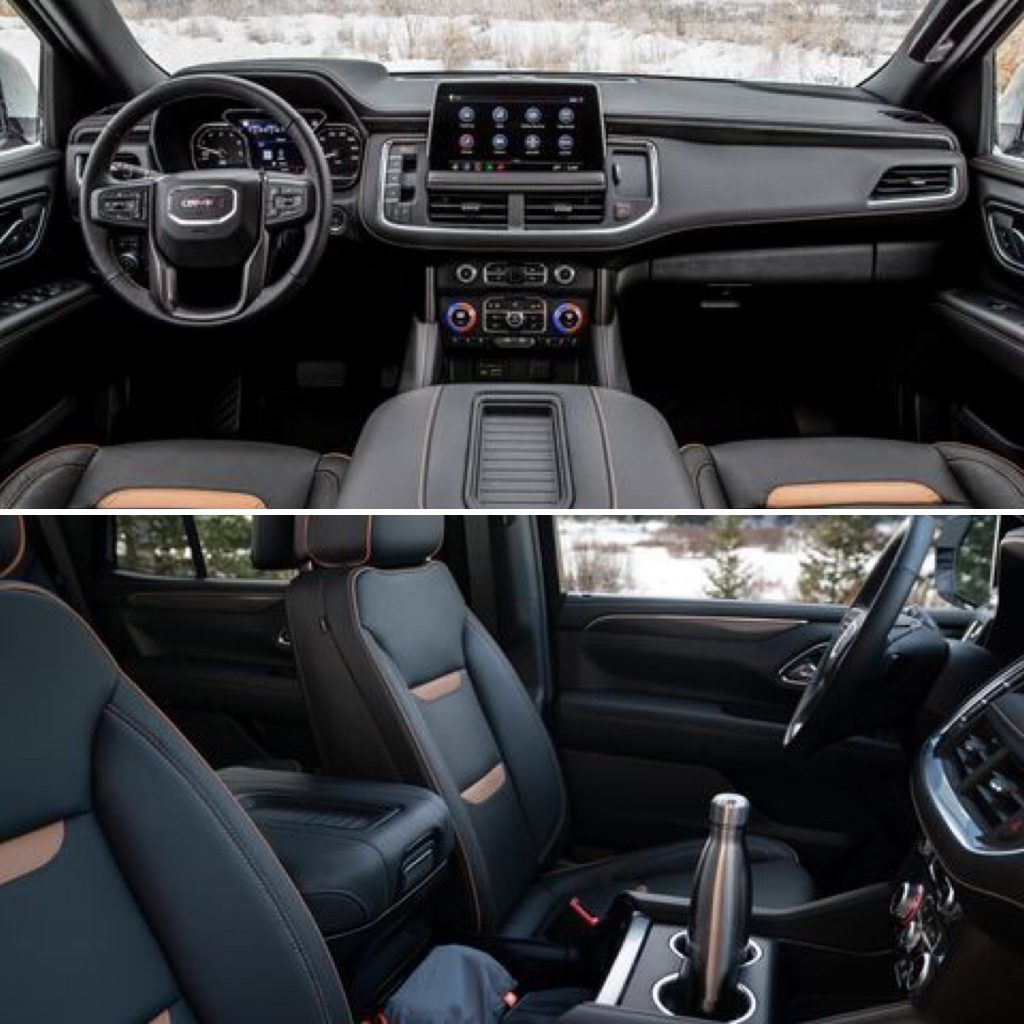
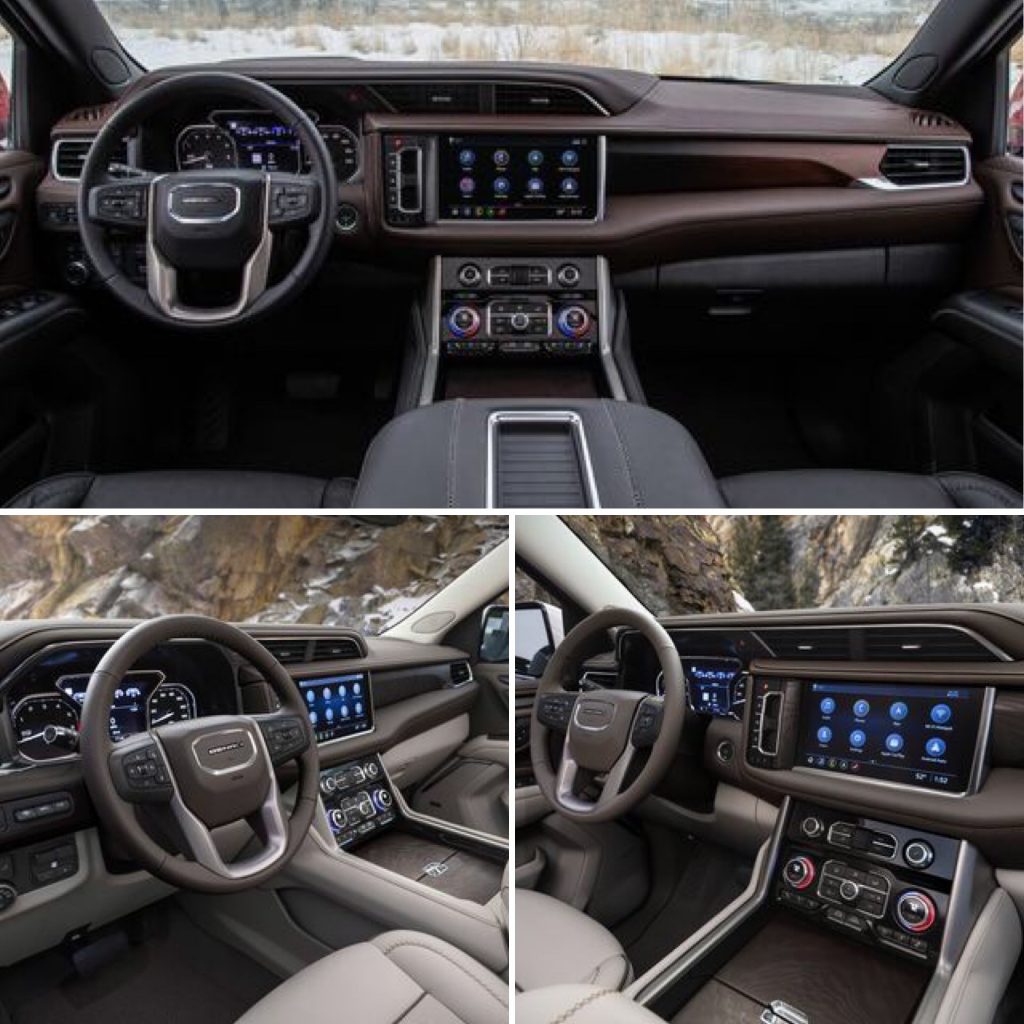
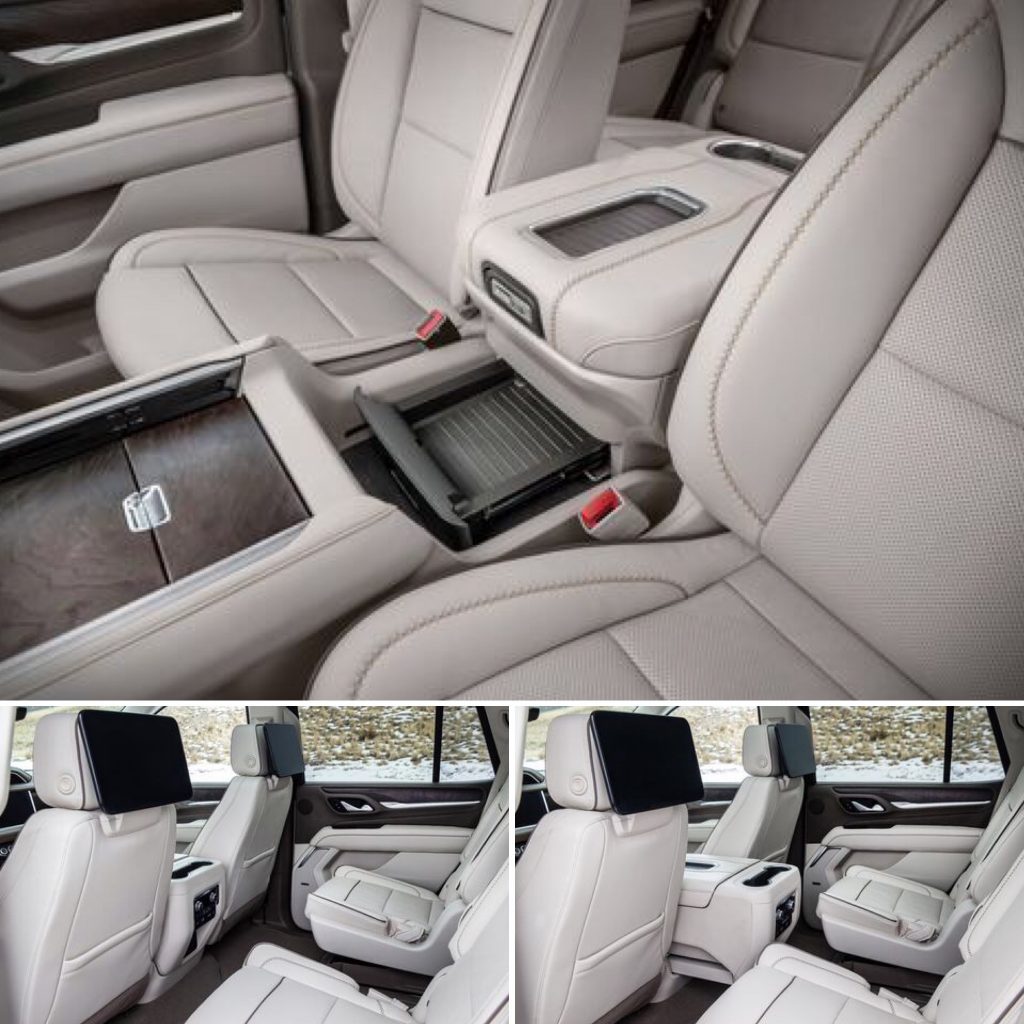

REVEALED: 2021 Tahoe & Suburban
Chevrolet has revealed the highly anticipated 2021 Suburban and Tahoe!
We are starting our pre-order list, so let us know if you are interested in ordering. They should be available this summer!
At the beginning of the year we wrote about the new Expedition/Expedition Max and how it had become a real contender in the full-size SUV field.
Well, it looks like GM is answering back with the new Tahoe/Suburban/Yukon and has taken a few notes from Ford to improve the best in the market SUV.
Besides the total redo of interior and exterior, the biggest standout on the new platform is an independent rear suspension (IRS), which Ford has had since 2004. The biggest benefit of this is that it allows for better interior space. The floor is able to be lower resulting in better leg and headroom for the third row and allows for a lower and FLAT rear cargo area. IFS also allows for a better and more agile ride.
We still have a lot more to learn about the new platform and finally, they have revealed the Yukon/Yukon XL, but we are waiting on the Escalade (though Escalade has a leaked image).
For now, here are the key points we know:
- The size difference between Tahoe and Suburban is a smaller delta than previous models because the Tahoe is bigger which results in 10” more length inside, most of which is cargo area behind the 3rd row.
- Push-button gear shift for the 10-speed transmission.
- The engine is the same, but improved, 5.3L V8 with a 6.2L V8 standard in High Country. We also assume it will be optional on the RST like current models. The big news on engines is an optional 3.0L Duramax diesel engine, but it won’t be available on the Z-71.
- Rear Entertainment is now dual 12.5” screens on the back of the front seat similar to the Land Cruiser.
- The sunroof is now panoramic, extending to second-row seats.
- Trim levels: LS, LT, RST, Z-71, Premier, High Country.
- The Z-71 goes back to a more aggressive off-road look and capability.
- High Country is a new trim level and would be compared to King Ranch. High Country will also come with a 6.2L V8.
- Adjustable air suspension will be on the Z-71 and High Country, giving 4” of adjustable ride height.

Quality, Not Quantity!
This has been our moto from day one. It’s what sets us apart and why our clients trust us with their pre-owned needs. Quality comes with a few costs though, make-ready expenses and time.
Make-ready consists of reconditioning, up to date maintenance, and making sure the vehicle comes with 2 sets of keys, floor mats, owner manuals, etc. We spend on average $2,000 on make-ready while the industry average is $600-$700 for domestic and $1,300 – $1,500 for luxury vehicles. This isn’t because we start with lower quality cars, instead most of the money is spent on what you don’t see, the maintenance. We have seen many vehicles in our shop that still have the paper plates on them come in for hundreds to thousands of dollars in maintenance. We also start with high quality cars that have not been in accidents and are a good platform for the reconditioning we do. With this quality, we back it up with our Brazelton Certified Program. This consists of a bumper-to-bumper 3-month/3,000-mile limited warranty and free Concierge Service (loaner car for life). Also, because of our make-ready process, vehicles qualify for a full coverage extended warranty, tire & wheel policy, and windshield protection.
The other cost of time is in regard to when our clients have us go out and find a vehicle for them. We are very particular on cars we present to our clients. We scour our wholesale and retail outlets and go through hundreds, if not thousands of cars to find one that fits our client’s needs and our standards. Depending on vehicle and flexibility on options it can take 2-6 weeks to find the right car. In some cases when looking for harder to find vehicles it can take 6+ weeks, so give us plenty of lead time when in the market for a pre-owned vehicle.
Occasionally we get some older unique cars, that due to their age we may not be as particular about every single item on them, but that doesn’t mean they are not a good vehicle. However, they’re still inspected just as thoroughly, but we may be more lenient on them to keep cost down, as these are typically more budget vehicles.
Remember, most used cars we sell are ones we go out and find for our clients, though we do stock a few vehicles. Most of these are trade-ins that we know the history on. Others are ones that we sell a lot of (Tahoes, Suburbans, Land Cruisers, F-150s) that we come across and scoop up for inventory. We may not always be the cheapest, but we promise we’ll be the best quality for the money, and we back it up!
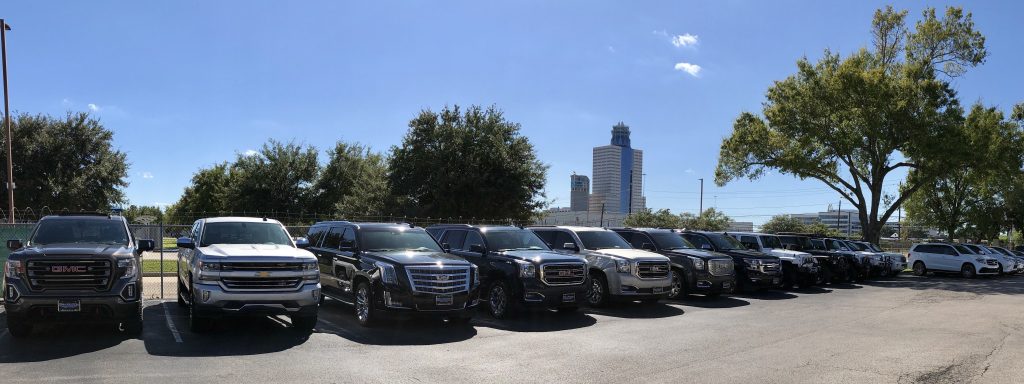
“Just an Oil Change Please.” Is that what you really want?
Today’s prescribed service intervals happen between 7,000 and 16,000 miles, or once a year. Quick oil change places only look at a small number of areas and employ techs with little or no experience of modern vehicles. They only focus on the limited services they offer, not on the overall health of your vehicle. Just like going to the doctor for an annual physical, your car needs that same physical.
At Brazelton Auto, our service includes an oil change and a “Vehicle Health Report” complete with pictures of potential problems. We pull the wheels off, rotate the tires, check the brakes, belts, hoses, battery, cooling system, all the fluid conditions, wiper blades, lights, and many other things on our 130-point inspection. This gives you peace of mind when you get your car back.

We have trained technicians and service advisors that understand which factory prescribed service interval is correct for your vehicle. Will our service cost a little more? Probably, but it will save you money in the long run. I could give you many examples of people trying to save money and it cost them time or damage to their car.
We know our oil-change service takes longer. That’s why we started our Concierge Service. After joining, you receive a nice, late model loaner car while your vehicle is being serviced or repaired. Just recently we started our “Lifetime Oil Change” service. For a set price, your oil service is done along with our 130-point Health Inspection for as long as you own the vehicle. Call our trained staff for all the details.




